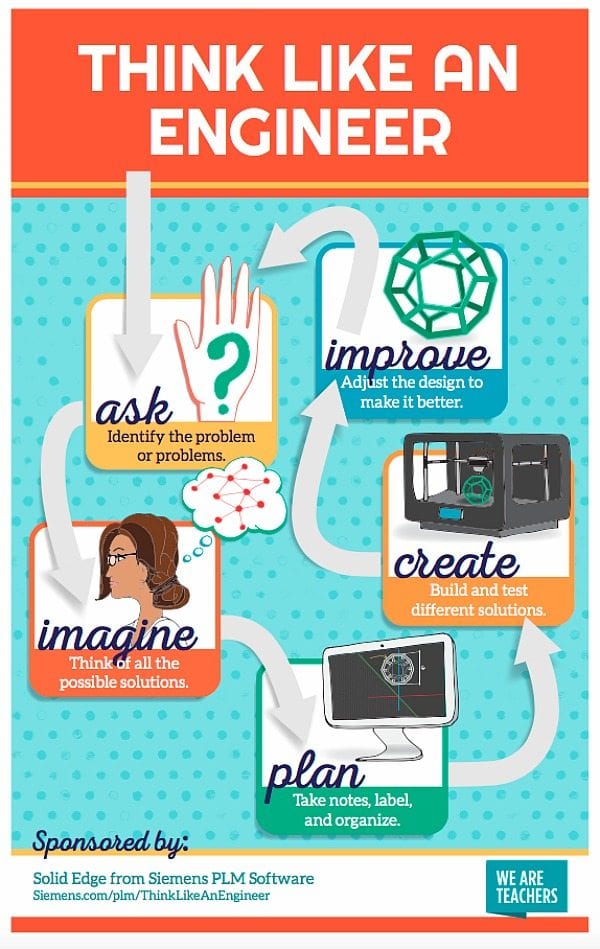All children are innately curious. Yet that shared drive to understand and shape the world hasn’t translated to equity in science, technology, engineering and mathematics (STEM). The science and engineering workforce in the United States is still overwhelmingly male, despite the fact that women now earn more than half of all undergraduate degrees.
The way you teach and talk about STEM has a profound impact on your students. These 8 tips are proven to spark (and sustain) girls’ interest in science, technology, engineering and math. Take a look at our video, too.
https://www.facebook.com/solidedge/videos/vb.124129637664022/1669651936445110/?type=2&theater
1. Emphasize all the creative parts of engineering.

“Creative, artistic students are often not interested in engineering because they think there’s just one answer,” says John Devitry, a Research Fellow at the Center of Space Engineering-Utah State University. But true innovation comes from unexpected combinations, so rather than emphasizing the linear and analytical side of engineering, talk about the importance of experimentation. Give students multiple opportunities to engage their artistic skills. Engineering is just as much about creative problem solving and artistic design as it is analytical skills, so actively encourage them to do both.
2. Ask your students what they’re interested in, and then do it.
Stephanie Greer, DREAM Lab® coordinator at The Baldwin School, a PK-12 girls’ school in Bryn Mawr, Pennsylvania, gives her students an interest inventory each year, and uses student passions to generate excitement about new skills. “When introducing them to the idea of designing a website or an app, I include their interests in my pitch: Maybe you’re really fanatic about gymnastics. You love animals and want to help people understand how to best care for them. Using their own words creates buy-in,” Greer says. Plus incorporating student interests keeps them engaged with the material and sparks interest.
Rachel Auslander, founder of Coder Gals, recommends Made with Code to stimulate girls’ interest in coding. The free website, “has a lot of different projects that relate to a lot of different interests,” Auslander says, including music, robotics, fashion and pop culture.
3. Help your student discover the power of visual-spatial skills.

Certain skills are necessary in STEM careers—and one of these, Devitry says, is the ability to envision and mentally manipulate shapes in space. You can help your students build their visual-spatial skills with GearUp, a free program that uses 3D computer aided design and creative challenges to build student capacity. No expertise is required to implement the program; teachers need only facilitate student exploration. By using these types of programs and strengthening visual-spatial skills, you are really helping prepare students for STEM.
4. Don’t over-emphasize math and science—there’s so much more to engineering.
One of the “biggest barriers” to pursuit of a STEM career is students’ belief that they must be “good at” math and science, says Laura Laing, author of Math for Grownups and a former middle and high school math teacher. That “very dangerous belief” causes a lot of creative people to discount STEM fields ‘because they’re afraid of the coursework that leads up to it,” says Randy Freeman, director of student programming for the Society of Women Engineers. As a teacher, remind students that they don’t have to be perfect at science and math. Engineering is more about creative problem solving. Focus on this first!
5. Put tools in their hands, and let them experiment.

Natascha Neptune grew up helping her dad and uncles fix cars in the driveway. “I was the little helper,” says Neptune, a senior mechanical engineer at the Wm. Wrigley Jr. Company. “That’s what influenced my decision to go into mechanical engineering.”
Unfortunately, many girls don’t get the opportunity to do hands-on work at home or school, unless it’s arts and crafts, says Julia Imbarrato, a science teacher at Keene High School in New Hampshire.
The Baldwin School’s Greer recommends giving girls broad exposure to—and reasons to use—all kinds of tools, including sensors, probes, power tools and CNC machines. “One thing we should be teaching girls is that they’re capable of learning anything, including how to use tools that have traditionally been in other people’s hands,” she says. One really powerful tool is the Solid Edge software available for free download.
6. Surround them with support …lots and lots of good support.

Auslander started Coder Gals to provide other girls with the support she didn’t have as a young girl. “I learned how to code in 6th grade, but I didn’t have any female role models to look up to. I didn’t have any friends interested in coding. So I lost interest,” she says. Be sure to have a network for support that will help reinforce skills. This will likely increase their level of participation and promote long-term interest. Coder Gals and SWENext, an offering of the Society of Women Engineers, give girls a chance to connect with other girls who share their interests.
7. Find projects that help others—students love this.
Research has shown that girls (and boys) respond favorably when STEM careers are positioned as an opportunity to help people. Talking about engineering and science as a way to solve problems and improve lives can capture the interest of young humanitarians, and provide the spark they need to persist. Programs such as Engineer a Better World and Design Squad Global offer inspiration and project ideas.
8. Connect with women who are working in STEM careers right now!

Girls who see women working in STEM careers are more likely to consider a career in science, technology, engineering or math. That’s one reason why Neptune volunteers at school career days. “I bring a package of gum and ask students, ‘How do you think we make this?’ Then I tell them I work on machines that make and wrap gum,” Neptune says. Consider checking out events by Society of Women Engineers, which gives girls the opportunity to work with professional engineers and other girls to solve problems and earn the recognition and respect of peers and industry professionals. You can use also Nepris to virtually connect girls with women working in a wide variety of industries, no matter where you live or teach.
At the end of the day, teachers can do a lot to help promote STEM with girls. Even highlighting cool projects or being a welcoming voice can go a long way. Plus, giving them the right software is huge. To download the Solid Edge software for free, go here.
Want a free “Think Like an Engineer Poster” as seen below? Download it here!



